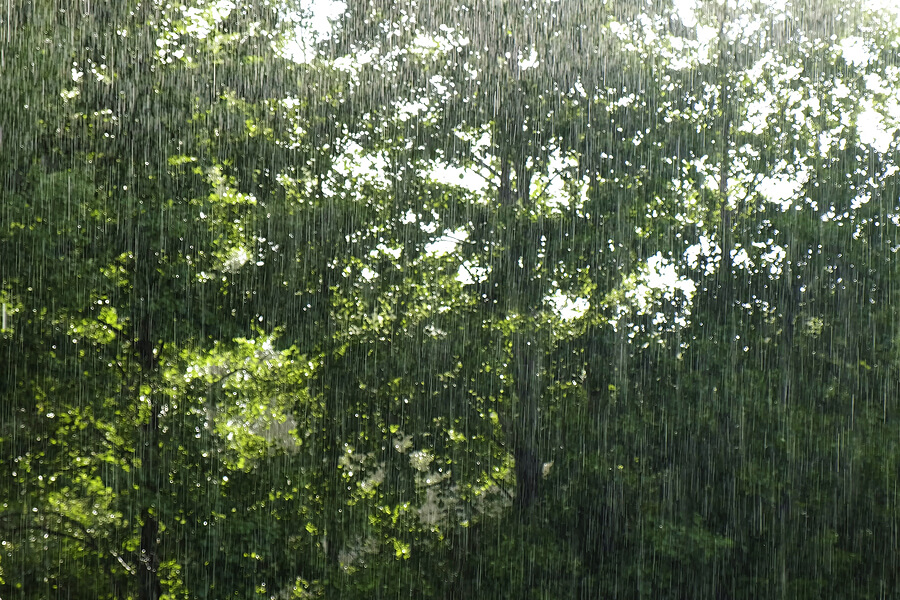Why Rain Does Not Fall As A Large Waterfall But As Drops

Have you ever looked up during a rainy day and wondered why rain falls as drops, not as a gigantic waterfall? Chances are you are not alone.
Our science materials in school taught us that water moves continuously through various states, in the atmosphere and on Earth. The evaporation process involves the water in oceans, seas, and lakes converting into water vapour. At the atmosphere, the water condenses, forming clouds, which fall back to Earth as hail, snow, or rain. These processes known as water cycle, a key factor in Earth’s habitability.
Hence, how does rainfall, instead of a gigantic waterfall, occurs as raindrops? Let us find out in this post.
How raindrops develop?
When the warm air comes in contact with the ground, it sucks every moisture up into the atmosphere, cooling the ground in the process. The water vapour that is in the atmosphere then cools and condenses, forming a cloud. Depending on the air’s temperature and altitude in the atmosphere, the cloud formed may comprise either tiny water droplets or ice crystals.
The difference in composition causes the formation of different types of cloud, which includes the common types we see, such as cumulonimbus and nimbus clouds, also known as rain clouds.
What are cumulonimbus and nimbus clouds?
Cumulonimbus clouds appear in the form of massive cloud towers that looks like buildings and are signs of impending lightning, thunder or hail storms. Nimbus clouds, on the other hand, are dark, huge grey clouds that indicate an impending downpour.
How water vapour condenses?
For water vapour to become rain, it requires “condensation nuclei”, which may come in the form of a tiny pollen particle or dust that is carried up by wind caused by a change in density, pressure, and temperature.
Once the water droplets in the cloud reach a specific weight and size at which they are able to resist the upward pulling force, and thermal force, they then fall back to Earth as rain.
Before falling back to Earth, a raindrop moves through the sky, attracting many particles of tiny aerosol towards the raindrop’s surface. The coagulation process in which the aerosols and droplets combine together results in an increase in the raindrop’s size. However, no matter how hard it rains, the average diameter of one raindrop is only at most 5mm. Why?
Basically, the air’s frictional drag is larger than the raindrop’s surface tension. As a result, larger raindrops do not stay that size as it falls down to Earth, fragmenting as they travel downwards.
Frictional drag, a form of drag, occurs when a fluid travels against a moving object’s surface. Surface tension is the result of the liquid’s surface resistive properties towards an external force. It is how things like insects and razor blades are able to float on water despite being denser than water.
How rain occurs?
Most rain starts off as solid snow crystals. However, when the fragments of ice enters warmer regions, such as Singapore, they end up melting and falling as raindrops. As they fall, gravity speeds them up. When a raindrop falls, it generates a wake which refers to the warped flow in the region caused by a solid body travelling through a fluid.
The occurrence of wake results in another raindrop coming after one another. As the raindrop falls faster, the air around it slows it down. Hence, sometimes the raindrop might not fall if the rising air currents are able to hold it up in the clouds. However, once the raindrop gets big enough, it will fall as rain.
The larger a raindrop is, the more likely it will clash with other raindrops. As a result, each raindrop might differ in size, which means falling at a different speed. When raindrops collide with one another, some will combine together to form bigger raindrops, while others might break into smaller ones. Therefore, as raindrops increase in number, so does the amount of rainfall.
A collision between raindrops does not guarantee the merging of raindrops. Studies have shown that the electric current found in the air is vital in the merging or separating of raindrops. The speed of the falling of raindrops is affected by each raindrop’s size. Larger drops fall at a faster rate.
With the combination of the air’s electric current, the raindrops fall next to one another rather than in a steady water stream. Hence, the scientific explanation behind why rain falls as drops rather than a gigantic waterfall.
Conclusion
Understanding the physics behind natural phenomena is vital in helping us understand the world better. And all that can be understood better at Physics Tuition, Singapore’s first-class tuition for all things physics. Find out more about us at http://www.physics.com.sg/ today!